
Hackescher Markt ("Hacke's Market") is a square in the central Mitte locality of Berlin, Germany, situated at the eastern end of Oranienburger Strasse. It is an important transport hub and a starting point for the city's nightlife.

Hackescher Markt ("Hacke's Market") is a square in the central Mitte locality of Berlin, Germany, situated at the eastern end of Oranienburger Strasse. It is an important transport hub and a starting point for the city's nightlife.
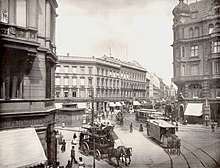
Originally a marsh north of the city fortifications on the road to Spandau, the Prussian king Frederick the Great about 1750 had a market square laid out under the surveillance of Townmajor Hans Christoph Friedrich Graf von Hacke in the course of a northern town expansion. It was officially named after Hacke on 23 July 1840.
In 1882 the area received access to the Berlin Stadtbahn railway line at Berlin Hackescher Markt station, then called Börse after the nearby stock exchange. The station was renamed Marx-Engels-Platz during the GDR era. [1] The railway tracks of the S-Bahn along the eastern and northern sections of Mitte between the stations Hackescher Markt and Jannowitzbrücke are built where the ramparts, walls, moats and glacis of the Berlin Fortress, a 17th century bastion fort around the historic city limits, had been.
Formerly a rather neglected area, Hackescher Markt with its old buildings has developed into a cultural and commercial centre after German reunification, famous for its nightlife [2] centered on the Hackesche Höfe courtyard ensemble. The square is also served by several tramway and night bus lines. A weekly market is still held every Thursday and Saturday.


Schloßplatz is a square located on Museum Island (Museumsinsel) in Berlin, Germany. It measures about 225 m by 175 m, with its long side oriented on an axis approximately southwest/northeast. At its west corner is the Schlossbrücke, from which Unter den Linden leads west to the Brandenburg Gate. From the same corner, Karl-Liebknecht-Straße runs northeast alongside the square and on to Alexanderplatz. Until the early 20th century, only the square south of the palace was so named, the square north of it being the Lustgarten.
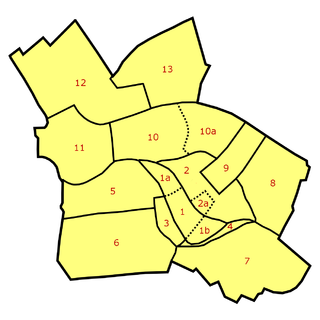
Scheunenviertel (help·info) is a neighborhood of Mitte in the centre of Berlin. It is situated to the north of the medieval Altberlin area, east of the Rosenthaler Straße and Hackescher Markt.

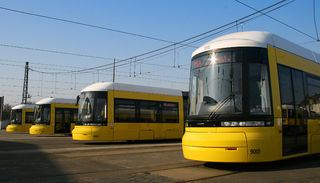
The Berlin tramway is the main tram system in Berlin, Germany. It is one of the oldest tram networks in the world having its origins in 1865 and is operated by Berliner Verkehrsbetriebe (BVG), which was founded in 1929. It is notable for being the third-largest tram system in the world, after Melbourne and St. Petersburg. Berlin's tram system is made up of 22 lines that operate across a standard gauge network, with almost 800 stops and measuring almost 190 kilometres (120 mi) in route length and 430 kilometres (270 mi) in line length. Nine of the lines, called Metrotram, operate 24 hours a day and are identified with the letter "M" before their number; the other thirteen lines are regular city tram lines and are identified by just a line number.

Berlin Hauptbahnhof is the main railway station in Berlin, Germany. It came into full operation two days after a ceremonial opening on 26 May 2006. It is located on the site of the historic Lehrter Bahnhof, and on the Berlin S-Bahn suburban railway. The station is operated by DB Station&Service, a subsidiary of Deutsche Bahn AG, and is classified as a Category 1 station, one of 21 in Germany and four in Berlin, the others being Berlin Gesundbrunnen, Berlin Südkreuz and Berlin Ostbahnhof.

Karl-Liebknecht-Straße is a major street in the central Mitte district of the German capital Berlin. It is named after Karl Liebknecht (1871–1919), one of the founders of the Communist Party of Germany. The street connects the Unter den Linden boulevard with the Prenzlauer Allee arterial road leading to the northern city limits. Although part of the street dates back to medieval times, most of the buildings at its side were built in the 1960s, when East Berlin's centre was redesigned as the capital of East Germany.

Oranienburger Straße is a street in central Berlin. It is located in the borough of Mitte, north of the River Spree, and runs south-east from Friedrichstraße to Hackescher Markt.
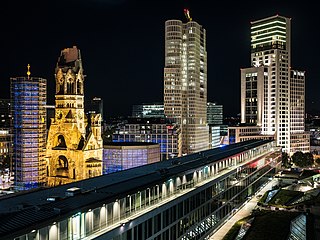
Breitscheidplatz is a major public square in the inner city of Berlin, Germany. Together with the Kurfürstendamm boulevard, it marks the centre of former West Berlin and the present-day City West. It is named after Rudolf Breitscheid.

The Berlin Stadtbahn is a major railway thoroughfare in the German capital Berlin, which runs through Berlin from east to west. It connects the eastern district of Friedrichshain with Charlottenburg in the west via 11 intermediate stations including Hauptbahnhof. The Berlin Stadtbahn is often also defined as the slightly longer route between Ostkreuz and Westkreuz, although this is not technically correct.

Berlin Hackescher Markt is a railway station in the Mitte district of Berlin, Germany. It is named after the adjacent Hackescher Markt square.
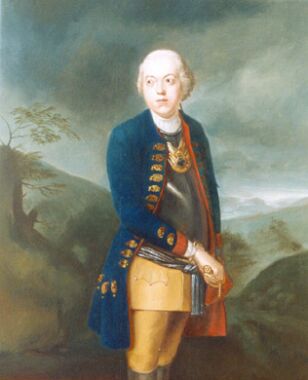
Hans Christoph Friedrich Graf von Hacke was a Prussian General and Commandant of Berlin. The Hackescher Markt in Berlin is named after him.

Alt-Berlin, also spelled Altberlin, is a neighborhood (Stadtviertel), situated in the Berliner locality (Ortsteil) of Mitte, part of the homonymous borough. In the 13th century it was the sister town of the old Cölln, located on the northern Spree Island in the Margraviate of Brandenburg. The neighbourhoods (Viertel) of Nikolaiviertel, Marienviertel, Klosterviertel are within Alt-Berlin.

The Berlin Fortress was the fortification of the historic city of Berlin. Construction started in 1650. The ramparts, walls, moats and glacis of the 17th-century bastion fort ran around the historic city limits. The demolition of its ramparts began in 1740.

The Hackesche Höfe is a notable courtyard complex situated adjacent to the Hackescher Markt in the centre of Berlin. The complex consists of eight interconnected courtyards, accessed through a main arched entrance at number 40 Rosenthaler Straße.

Molkenmarkt is the oldest square in Berlin. It is located in the Alt-Berlin quarter of the Mitte district, in the historic centre of the city. With approximately 9,200 square metres (11,000 sq yd) in size, it is today a major traffic junction, dominated by the large Altes Stadthaus administrative building on its southeastern side.

Berlin is the capital city of Germany and one of the 16 states of Germany. With a population of 3.4 million people, Berlin is the most populous city proper, the sixth most populous urban area in the European Union, and the largest German city.
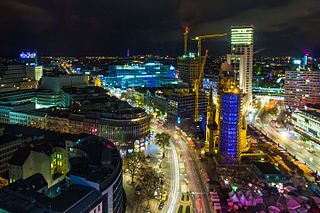
City West is an area in the western part of central Berlin. It is one of Berlin's main commercial areas, and was the commercial centre of former West Berlin when the city was divided by the Berlin Wall.

Spandauer Vorstadt is a historic district in what is now the Mitte district of Berlin.
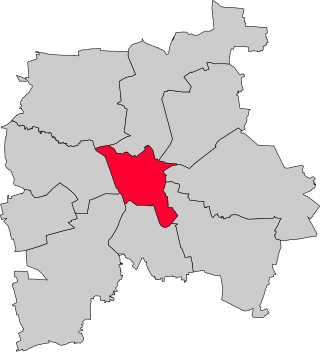
Leipzig-Mitte is one of ten boroughs (Stadtbezirke) of Leipzig, located in the center of the city. It includes numerous architectural monuments. Most of them are located in the subdivision "Zentrum", which is sited inside the Inner City Ring Road and the Promenadenring: